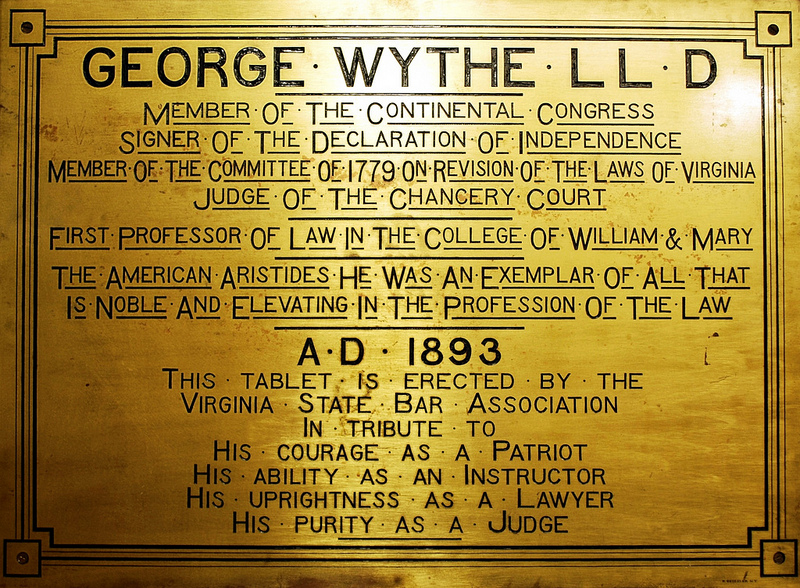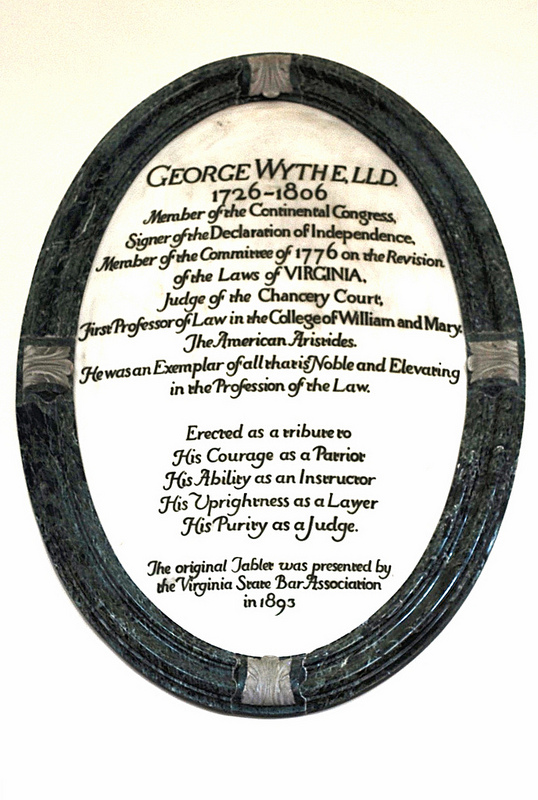Wythe Tablet
Reports of the Virginia State Bar Association
On July 30, 1891, at the third day of the third annual meeting of the Virginia State Bar Association, member W. W. Henry of Richmond offered the following resolution:
Whereas the grave of Chancellor George Wythe, in the churchyard of St. John's church, Richmond, Va., is unmarked,
Resolved, That the President of this Association appoint a committee of three, who shall ascertain as nearly as possible the locality of the said grave and report to this body at its next session, and at the same time report what will be the cost of a suitable one to be placed at or near said grave.[1]
The resolution was adopted, and the President named three men to make up the committee: W. W. Henry; R. G. H. Kean, of Lynchburg; and R. M. Hughes, of Norfolk.
At the 1892 meeting, on July 12, R. G. H. Kean submitted the committee's report. In their attempt to ascertain the location of Wythe's grave, Kean cited relevant passages from "The Two Parsons" by George Wythe Munford[2], and from the newspaper account of Wythe's funeral in the Richmond Enquirer. The committee concluded:
The language of the order of the Council, and the terms employed in this cotemporaneous notice of the funeral procession, appear to be quite conclusive of the fact that the interment was, as Colonel Munford states, in the church-yard of St. John's, Richmond.
The other is the room of the new City Hall in Richmond, which is to be set aside for its Chancery Court. We can imagine no greater incentive for the Bar of the present day than to have constantly under their eyes such memorials to the great jurists of the past.[3]
Quite extensive inquiry among old citizens of Richmond, who take an interest in matters of this nature, corroborates the conclusion of Colonel Munford, that the grave was on the west side of the church building and not far from the wall.
The precise spot could not now be ascertained, except, possibly, by exploration with the spade. But your committee is of opinion that if such a memorial stone, as seems contemplated by the resolution, were erected on that side of the church, and near the wall, it would be sufficiently near the place of interment to answer the purpose.
The committee, however, is much impressed with the ephemeral character of monuments exposed to the elements. For this reason, and the yet more controlling one, that a memorial such as this Association would be willing to erect, would cost several hundred dollars at the least, they are forced to abandon the idea of a monument at his grave, even if the grave could be exactly located.
But the committee is not willing to recommend that the Association relinquish the purpose of erecting a memento to such a man as Chancellor Wythe.
On consideration, they are of opinion that a mural tablet might be erected which would serve to hold him out to the profession as a great exemplar. Such tablets are not expensive, and, being protected, are practically unlimited in their durability.
The committee would recommend its erection in St. John's church but for the fact that this church is a wooden structure, which places it out of the question. Two other places suggest themselves as equally appropriate. One is the chapel of the College of William and Mary, at Williamsburg, of which institution he was an alumnus. He was long a resident of Williamsburg, and many of his greatest cotemporaries now sleep beneath that chapel.
After some debate, the resolution was amended to allow 'the location of the mural tablet be left to the discretion of the committee,'[4] and was adopted:
Resolved, That a committee of three be appointed by the President. whose duty it shall be to procure the assent and concurrence of the proper authorities, and cause to be erected, either in the court-room of the Chancery Court for the city of Richmond, in the new court-room to be erected in the city of Richmond for the Court of Appeals, or in the chapel of William and Mary College, a mural tablet, with a suitable inscription, to the memory of Chancellor George Wythe, at a cost not to exceed the sum of two hundred dollars; which sum shall be disbursed for said purpose by the Treasurer, upon the order of the chairman of said committee.
References
- ↑ Virginia State Bar Association, Proceedings of the Annual Meeting, 1891, p. 26.
- ↑ George Wythe Munford, The Two Parsons; Cupid's Sports; The Dream; and the Jewels of Virginia, Richmond, Virginia: J.D.K. Sleight, 1884, pp. 429-430.
- ↑ Virginia State Bar Association, Proceedings of the Annual Meeting, 1892, pp. 51-53.
- ↑ Proceedings, 1892, p. 16.

